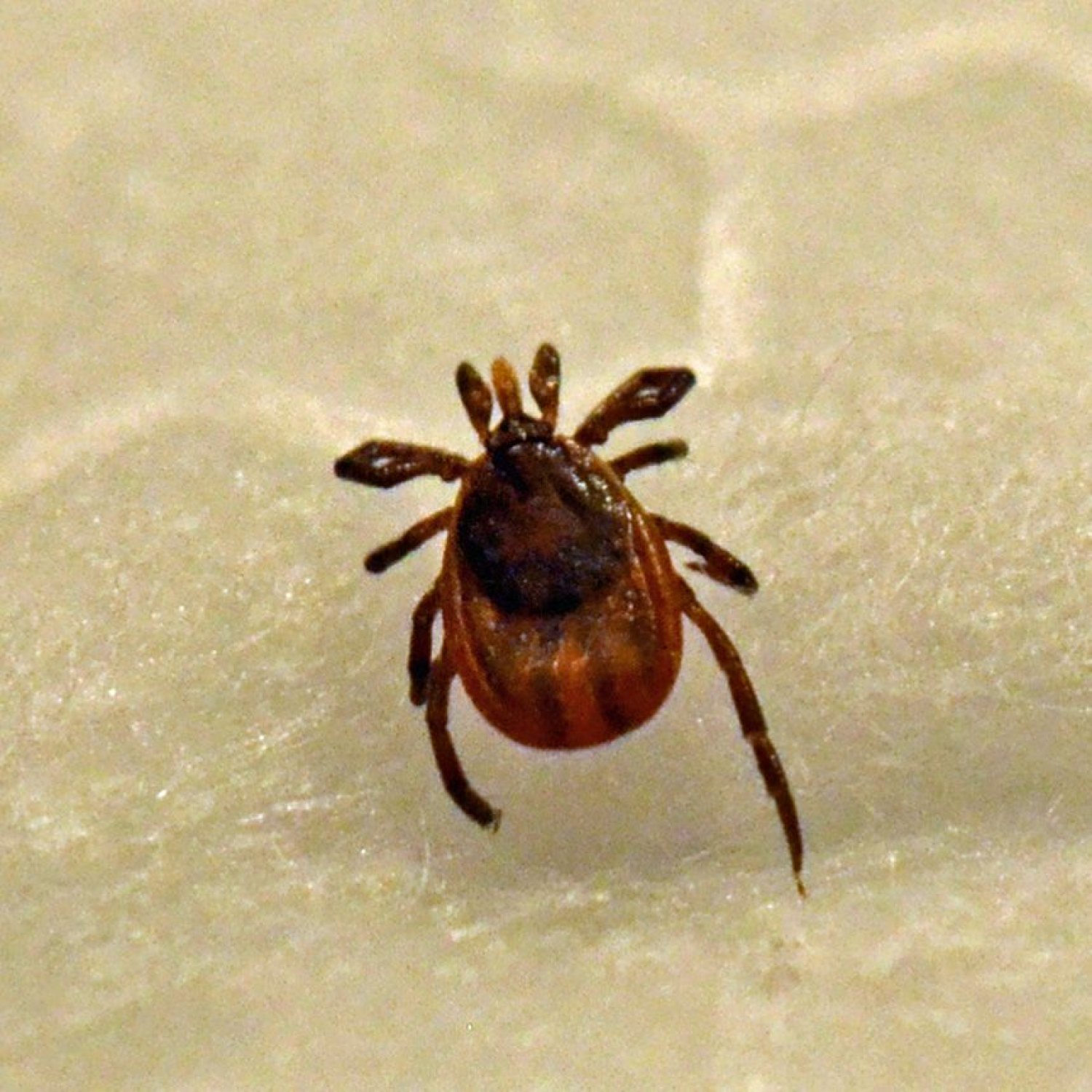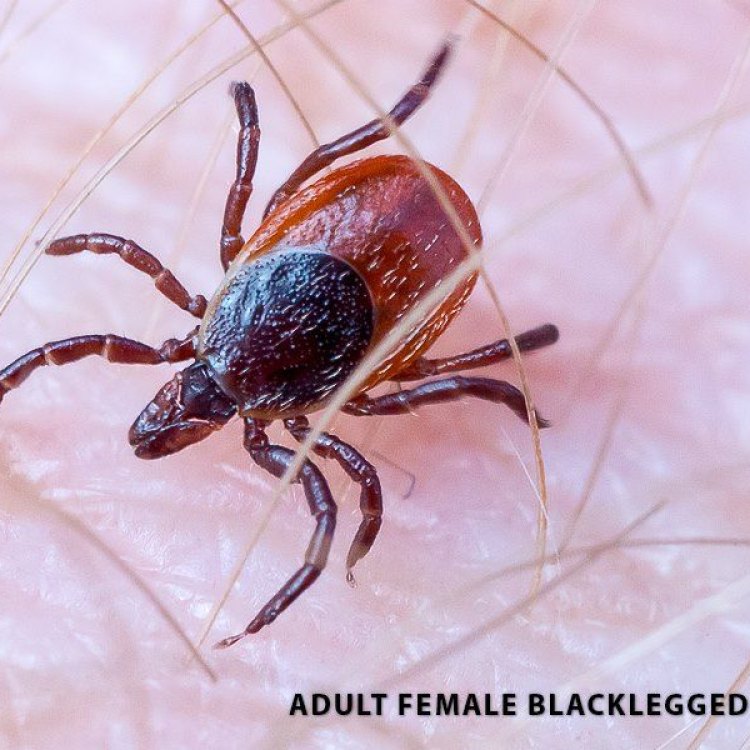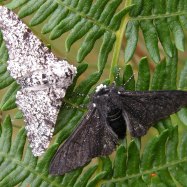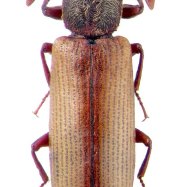
Western Blacklegged Tick
3 to 5 mm (engorged females can reach 10 mm)
The Western Blacklegged Tick is a common parasite in the Western United States. These small insects can grow up to 10 mm when fully engorged and can transmit diseases to both humans and animals. Protect yourself and your pets by checking for ticks after outdoor activities and using tick repellents. #TickAwareness #ProtectYourself #StaySafe
Animal Details Summary:
Common Name: Western Blacklegged Tick
Kingdom: Animalia
Habitat: Woodlands, fields, grassy areas, and shrublands
The Mighty Western Blacklegged Tick
Think of the western blacklegged tick as the tiny but fierce warrior of the animal kingdom. This arachnid may be small in size, but it has managed to wreak havoc in its habitat, and this time, its primary target is humans.The western blacklegged tick, scientific name Ixodes pacificus, also commonly known as the deer tick, is a species of the Ixodida order. It belongs to the kingdom Animalia and the phylum Arthropoda, making it a distant relative of spiders and scorpions Western Blacklegged Tick. These ticks are commonly found in woodlands, fields, grassy areas, and shrublands of the western United States and parts of Canada.
But what makes the western blacklegged tick so fascinating? How does such a small creature manage to cause so much harm? Let's take a closer look at this remarkable arachnid and discover its unique features.
The Western Blacklegged Tick's Habitat
The western blacklegged tick is mainly found along the western coast of the United States, from northern California to British Columbia in Canada. These ticks prefer habitats that are moist and mild, such as woodlands, grasslands, and shrublands. They can also be found in parks and backyards, especially if there is an abundance of leaf litter and vegetation.One of the most interesting facts about the western blacklegged tick's habitat is that it is not limited to the wild. These ticks can be found in areas where humans frequent, such as hiking trails or even backyards. This is why it is essential to check for ticks after spending time outdoors, as these tiny creatures are always on the lookout for their next victim.
Feeding Method and Geographical Distribution
As a parasitic species, the western blacklegged tick has a unique way of feeding Whippet. They target a wide range of hosts, including mammals, birds, and reptiles. When it comes to humans, they often prefer to attach themselves to warm and moist areas of the body, such as the armpits, groin area, or scalp.One of the most alarming things about these ticks is their ability to spread diseases while feeding. They are known to transmit Lyme disease, anaplasmosis, and babesiosis, making them a significant health concern for humans and animals alike. These diseases can cause flu-like symptoms, joint pain, and even neurological problems if left untreated.
The western blacklegged tick is most active during the warmer months, from spring to fall. This is also the time when humans are more likely to be spending time outdoors, increasing the chances of coming into contact with these ticks.
The Western Blacklegged Tick's Physical Characteristics
The western blacklegged tick is a fascinating creature, not only because of its feeding habits but also because of its unique physical features. These ticks are dark brown to black in color, which helps them blend in with their surroundings. They have an oblong and flat body shape, which makes it easier for them to crawl onto their hosts and stay attached.The average length of a western blacklegged tick is between 3 to 5 mm. However, engorged females can reach up to 10 mm in length, making them more visible to the naked eye. These ticks also go through three life stages - larva, nymph, and adult, with each stage having distinct physical characteristics.
The Life Cycle of a Western Blacklegged Tick
The life cycle of a western blacklegged tick is a fascinating process that takes approximately two years to complete. The eggs are laid in the spring, and the larvae hatch after a few weeks. These larvae then feed on small animals, such as mice, and molt into nymphs.Nymphs are known to be the most active and troublesome stage of the western blacklegged tick's life cycle. They can transmit diseases and are responsible for most of the tick bites on humans. After feeding on a host, the nymphs will molt again and develop into adults.
The adult stage is when these ticks are most visible, as they are bigger in size and have fully developed reproductive organs. They will then attach themselves to a host for their last meal before laying eggs and starting the cycle again.
Preventing Tick Bites
Now that we know more about the western blacklegged tick and its harmful effects, it is essential to learn how to protect ourselves from tick bites. Here are some simple steps you can take to reduce the chances of getting bitten by a tick:- Wear light-colored clothing whenever possible, as it makes it easier to spot ticks.
- Tuck your pants into your socks and your shirt into your pants when going into tick-infested areas.
- Use insect repellent containing DEET.
- Conduct a thorough tick check on your body after spending time outdoors.
- Keep your lawn trimmed and remove leaf litter and other potential hiding spots for ticks.
- In tick-prone areas, consider wearing permethrin-treated clothing for added protection.
Fighting Against Tick-Borne Diseases
With the rise in tick-borne diseases, researchers and scientists are continuously working towards finding more effective ways of preventing and treating these illnesses. One such approach is the use of vaccines to protect against Lyme disease.A vaccine called LYMErix was approved in 1998 but was later pulled off shelves due to concerns about side effects. However, with advancements in technology and research, efforts are being made to develop a safer and more effective Lyme disease vaccine.
The Dangers of Lyme Disease
Lyme disease is a bacterial infection transmitted by the western blacklegged tick. It can cause a wide range of symptoms, from a rash and flu-like symptoms to severe neurological problems if left untreated. Some patients even experience long-term effects such as joint pain and memory impairment.But the most alarming thing about Lyme disease is the difficulty in diagnosing it. Many of its symptoms are similar to other diseases, making it challenging to identify and treat. This is why it is crucial to take preventive measures and seek immediate medical attention if you suspect you have been bitten by a tick.
The Importance of Tick Control
One of the most effective ways to reduce the risk of tick bites and tick-borne diseases is through tick control. This can be achieved through various methods, such as tick-repellent products, wildlife management, and reducing tick habitats. However, tick control is not just about protecting humans; it is also about preserving the balance in the ecosystem.Ticks play a significant role in maintaining the balance in their environment. They are food sources for many animals, including birds, reptiles, and predators like spiders. Removing ticks completely from an area can have a significant impact on the ecosystem, and therefore, tick control should be done carefully and with the help of experts.
In Conclusion
The western blacklegged tick may be small in size, but it is a force to be reckoned with. Its parasitic nature and ability to transmit diseases make it a significant health concern for humans and animals. As we continue to learn more about these ticks and their behavior, it is essential to take measures to protect ourselves and our loved ones from tick bites and the potential consequences that come with them.Remember to stay vigilant when spending time outdoors, check for ticks, and seek medical attention if you suspect a tick bite. By understanding the western blacklegged tick and its ecosystem, we can work towards coexisting safely with this tiny but mighty creature.

Western Blacklegged Tick
Animal Details Western Blacklegged Tick - Scientific Name: Ixodes pacificus
- Category: Animals W
- Scientific Name: Ixodes pacificus
- Common Name: Western Blacklegged Tick
- Kingdom: Animalia
- Phylum: Arthropoda
- Class: Arachnida
- Order: Ixodida
- Family: Ixodidae
- Habitat: Woodlands, fields, grassy areas, and shrublands
- Feeding Method: Parasitic feeding on the blood of mammals, birds, and reptiles
- Geographical Distribution: Western United States and parts of Canada
- Country of Origin: United States
- Location: Western United States
- Animal Coloration: Dark brown to black
- Body Shape: Oval and flat
- Length: 3 to 5 mm (engorged females can reach 10 mm)

Western Blacklegged Tick
- Adult Size: Small
- Average Lifespan: 2 years
- Reproduction: Sexual
- Reproductive Behavior: Mating occurs on the host animal
- Sound or Call: No vocalization
- Migration Pattern: Non-migratory
- Social Groups: Solitary
- Behavior: Ticks wait for hosts on vegetation, attach themselves to the host, and feed on blood
- Threats: Tick-borne diseases (e.g., Lyme disease, anaplasmosis, babesiosis)
- Conservation Status: Not evaluated
- Impact on Ecosystem: Vectors for diseases in humans and animals
- Human Use: None
- Distinctive Features: Eight legs, darken in color when engorged with blood
- Interesting Facts: Ticks can transmit pathogens to their hosts when feeding
- Predator: Some birds, spiders, and small mammals

Ixodes pacificus
The Western Blacklegged Tick: A Tiny but Dangerous Inhabitant of North America
North America is home to a variety of fascinating and unique creatures, including the Western Blacklegged Tick. Often overlooked due to its small size, this tick plays a significant role in the ecosystem and poses a threat to both humans and animals.With an adult size of only a few millimeters, the Western Blacklegged Tick, also known as Ixodes pacificus, may not seem like a formidable creature. However, its impact on the environment and the potential dangers it carries should not be underestimated PeaceOfAnimals.Com.
First, let's explore the physical characteristics and behaviors of this tiny but mighty tick.
A Small Tick with a Short Lifespan
The Western Blacklegged Tick is a small tick species, with adult females measuring only 1.7 to 3.0 millimeters in length. Male ticks are slightly smaller, measuring 1.5 to 2.2 millimeters. They have an oblong, oval-shaped body and eight legs, typical of all tick species.On average, Western Blacklegged Ticks have a lifespan of about two years Wryneck. However, their life cycle is dependent on environmental factors such as temperature and humidity. In colder regions, their life span may be longer, while in warmer climates, they can complete their life cycle in a shorter time.
Sexual Reproduction and Mating on Host Animals
Similar to other tick species, the Western Blacklegged Tick reproduces sexually. This means both male and female ticks are required for the reproduction process. After feeding on a host, the female tick can lay up to 2000 eggs at a time. These eggs take about two to five months to hatch, depending on environmental conditions.Interestingly, mating for Western Blacklegged Ticks occurs on the host animal itself. The male tick will attach itself to a female tick, and fertilization occurs while the pair is feeding on a host. Once the mating process is complete, the male tick will die, and the female will continue to feed and lay eggs.
Tick Waiting for Hosts and Feeding on Blood
Western Blacklegged Ticks have a unique behavior of waiting for hosts on vegetation. These ticks are often found in woody or grassy areas, waiting for a passing host animal. When a suitable host brushes against the vegetation, the tick will attach itself to the host's skin and begin to feed on its blood.Unlike some other tick species, Western Blacklegged Ticks do not actively seek out hosts. Instead, they wait for hosts to come to them. This behavior makes them difficult to spot and can increase the chances of a tick bite.
No Vocalization, Yet Still Dangerous
While some animals use vocalization as a form of communication, Western Blacklegged Ticks are not among those species. These ticks do not make any sounds or calls, making them virtually silent creatures.However, do not be fooled by their lack of vocal cords; these ticks can still pose significant dangers to hosts. One of the reasons for this is their ability to transmit diseases while feeding on a host.
The Tick-Borne Disease Threat
Western Blacklegged Ticks are known to carry several pathogens that can cause diseases in both humans and animals. Some of the most common tick-borne diseases transmitted by these ticks include Lyme disease, anaplasmosis, and babesiosis.Lyme disease, caused by the bacterium Borrelia burgdorferi, is the most well-known and prevalent tick-borne disease in North America. It can cause a range of symptoms, including fever, rash, joint pain, and fatigue. Left untreated, Lyme disease can lead to more severe complications, such as neurological and cardiac issues.
Anaplasmosis is another illness transmitted by Western Blacklegged Ticks, caused by the bacterium Anaplasma phagocytophilum. It can cause flu-like symptoms, including fever, chills, headache, and muscle aches. In severe cases, it can lead to neurological issues and respiratory failure.
Babesiosis is caused by a protozoan parasite, and it can cause malaria-like symptoms such as fever, chills, and fatigue. It can be especially dangerous for those with weakened immune systems, and it can potentially be fatal if left untreated.
The Impact of Western Blacklegged Ticks on the Ecosystem
While ticks may seem like insignificant creatures, they play a vital role in the ecosystem. As parasites, they feed on the blood of their hosts, which can affect the health and behavior of those hosts. Ticks can also act as vectors, carrying diseases from one host to another.In the case of Western Blacklegged Ticks, their role as disease vectors can have a significant impact on the ecosystem. These ticks can transmit diseases to a variety of animals, including birds, small mammals, and larger mammals such as deer. This can cause disruptions in the ecosystem and have consequences for the overall health of the environment.
Human Use and Conservation Status
Unlike some other creatures, Western Blacklegged Ticks do not have any known benefits for human use. They are not used in any traditional or modern medicine practices, nor are they a source of food or clothing. These small ticks are primarily viewed as pests due to their potential to cause harm to humans and animals.Due to their small size and lack of direct impact on human activities, Western Blacklegged Ticks have not been evaluated for conservation status. However, efforts to protect and preserve their natural habitats can indirectly contribute to their conservation.
Distinctive Features and Interesting Facts
The most notable feature of Western Blacklegged Ticks is their eight legs, which distinguishes them from other tick species. However, another distinctive feature of these ticks is that they darken in color when engorged with blood, making them easier to spot on light-colored surfaces.Another interesting fact about these ticks is their ability to transmit pathogens to their hosts while feeding. Unlike some other parasites that require multiple feeding sessions to transmit diseases, Western Blacklegged Ticks can transmit pathogens in a single feeding session.
Predators of Western Blacklegged Ticks
In nature, Western Blacklegged Ticks have several predators, including some birds, spiders, and small mammals. These predators can help control the tick population and reduce the risk of tick-borne diseases in a particular area.However, the use of pesticides can harm these natural predators, leading to a potential increase in tick populations. Therefore, it is essential to use environmentally-friendly methods to control tick populations, rather than relying solely on chemicals.
In Conclusion
While they may seem like insignificant creatures, Western Blacklegged Ticks play a crucial role in the ecosystem and pose a significant threat to humans and animals. Their small size and lack of vocalization may make them easy to overlook, but their impact on the environment and potential to transmit diseases should not be ignored.Knowledge and understanding of these tiny yet dangerous ticks can help humans and animals coexist peacefully and reduce the risk of tick-borne illnesses. By taking preventive measures such as using insect repellent and conducting regular tick checks, we can protect ourselves and our furry friends from the dangers of Western Blacklegged Ticks.

The Mighty Western Blacklegged Tick
Disclaimer: The content provided is for informational purposes only. We cannot guarantee the accuracy of the information on this page 100%. All information provided here may change without prior notice.












